Key takeaways
- Ableton Live’s Session View encourages creativity through non-linear music production, allowing for improvisation and detailed tweaking.
- Understanding fundamental concepts like arrangement and dynamics is crucial for impactful music production.
- Automation of effects and levels brings life to tracks, making subtle shifts that enhance listener engagement.
- Adopting a “less is more” approach and taking breaks during production can improve workflow and lead to better sound quality.
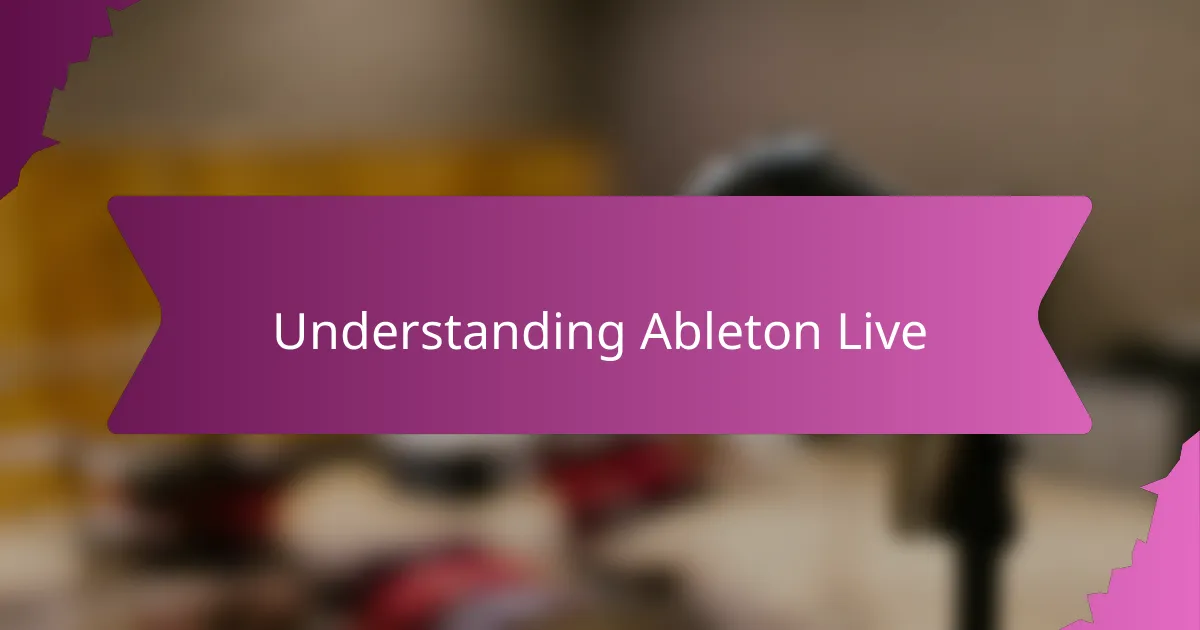
Understanding Ableton Live
Ableton Live is more than just a digital audio workstation to me; it’s like a creative companion that adapts to the way I think and work. The session view, in particular, changed how I approach music – it feels like improvising in a live setting, but with the power to tweak every detail afterward. Have you ever found yourself stuck trying to organize your musical ideas? Ableton’s non-linear approach helps break that barrier and keeps the creative flow flowing.
What really sets Ableton apart, in my experience, is its intuitive workflow combined with powerful tools. From slicing samples to automating effects, it honestly feels like the software understands my musical intentions before I fully form them. This intuitive feel reduces the technical frustration, letting me focus more on the music’s emotional impact.
I also appreciate how Ableton Live integrates seamlessly with hardware controllers, which makes producing feel tactile and immediate. I remember the first time I used my MIDI controller to launch clips live—it was almost like having an instrument in my hands rather than a computer screen. That hands-on interaction turned music production into an engaging, almost playful experience for me.

Basics of Music Production
Music production, at its core, is about shaping sound to tell a story or evoke a feeling. When I started, I realized how essential it was to grasp the basics—things like understanding beats, melodies, and how different sounds interact. Without that foundation, mixing clips or layering instruments felt random and overwhelming.
Have you ever wondered why some tracks instantly catch your attention while others don’t? For me, it boiled down to learning the importance of arrangement and dynamics—knowing when to build tension and when to let the music breathe. Those small skills helped transform simple loops into tracks that actually move people.
I also discovered that exploring basic effects like EQ, compression, and reverb can completely change a sound’s vibe. Early on, I would experiment endlessly, sometimes ruining a mix, but those mistakes taught me which tools enhance a track subtly and which ones overpower it. Getting comfortable with these fundamentals gave me the confidence to express my own musical voice.
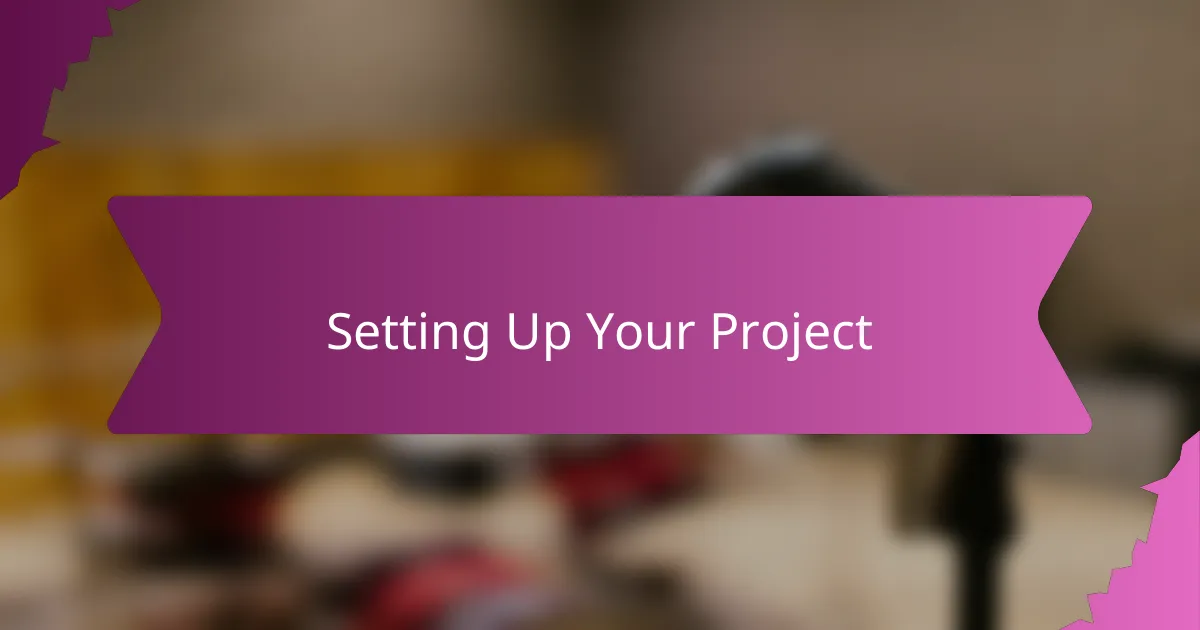
Setting Up Your Project
Getting started with Ableton Live, the first thing I focus on is setting up the project correctly. I take a moment to choose the right sample rate and organize my folders so that everything from samples to presets is easy to find. This small step saves me a lot of frustration later on—have you ever jumped into production only to lose time searching for files?
Next, I create a basic project template that includes my go-to instruments and effect racks. Over time, I’ve tweaked this template to match my workflow, so it feels like I’m jumping straight into the creative zone rather than fiddling with settings. It’s surprising how a little initial organization can make the whole session feel smoother and more inspiring.
Finally, I always set my tempo and key early on. This might sound simple, but locking those down helps me stay focused and makes sure all my clips and loops work harmoniously. I remember one time I ignored this step and ended up with a chaotic mix that just didn’t gel—lesson learned!
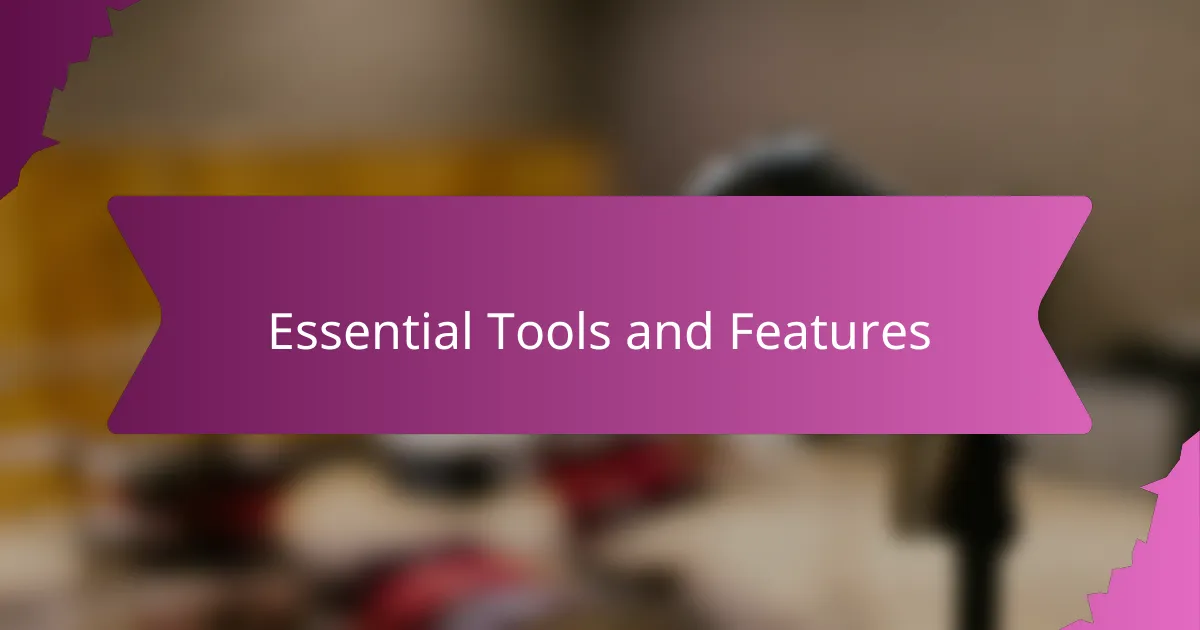
Essential Tools and Features
When I dive into Ableton Live, the first tool I rely on is the Session View. It’s like having a creative sandbox where I can instantly trigger loops and ideas without worrying about the arrangement just yet. Have you ever felt stuck trying to decide what fits where? This non-linear approach helped me break free from that creative block.
Another essential feature for me is Ableton’s automation lanes. Being able to draw precise changes in volume, effect parameters, or filter sweeps adds so much life to a track. I remember crafting a build-up where the tension grew gradually, and watching those automation curves felt almost like painting sound with light.
Finally, Drum Racks and Simpler have been my go-tos when shaping beats and manipulating samples. They make the process tactile—drag, drop, tweak—and suddenly, random hits turn into grooves that feel alive. Isn’t it amazing when a simple tool transforms your ideas into something you can really move to?
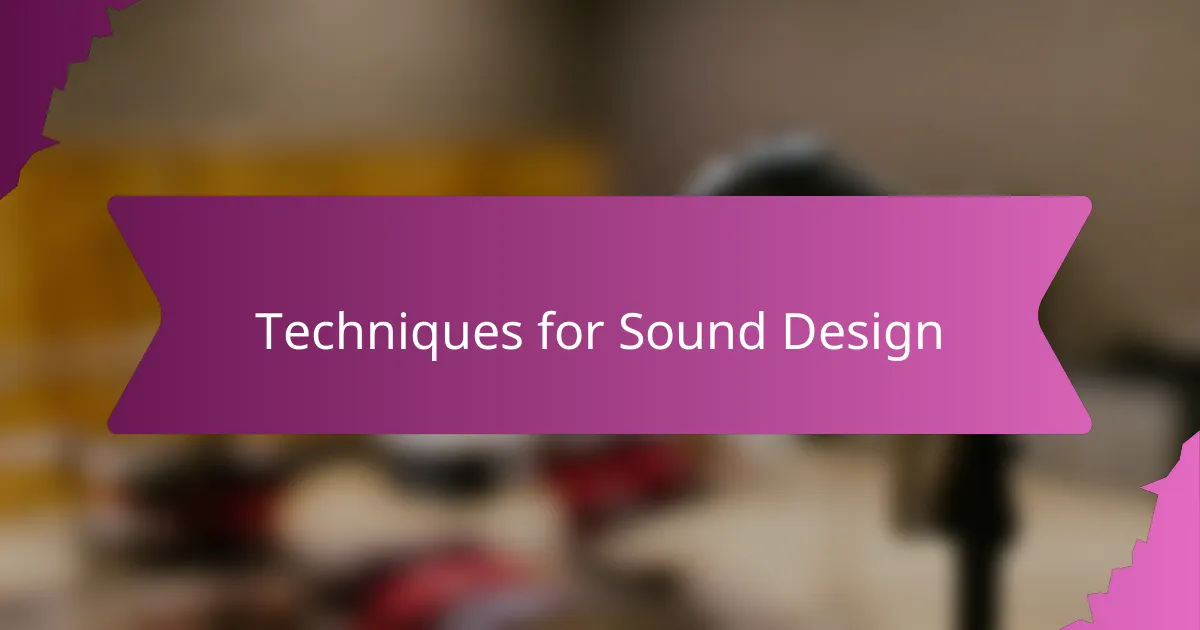
Techniques for Sound Design
One of my favorite sound design techniques in Ableton Live is layering multiple instruments and samples to create rich, textured sounds. I often start with a basic synth patch, then blend in atmospheric pads or subtle field recordings using different effect chains. Have you ever noticed how a well-crafted layer can turn a simple melody into an immersive experience?
Another approach I rely on is using Ableton’s built-in effects like frequency shifters and grain delays to transform ordinary sounds into something fresh and unexpected. Sometimes, just tweaking parameters while listening closely leads to happy accidents—those moments when a sound morphs into an entirely new character that sparks fresh ideas. It’s these surprises that keep sound design exciting for me.
I also like to experiment with automation, especially when sculpting evolving textures. Drawing gradual filter sweeps or modulating reverb sends over time adds movement and emotional depth to static sounds. In my experience, this dynamic shaping often distinguishes a flat mix from one that truly breathes and connects with the listener. Have you tried automating effects to bring life to your tracks? It’s surprisingly empowering.
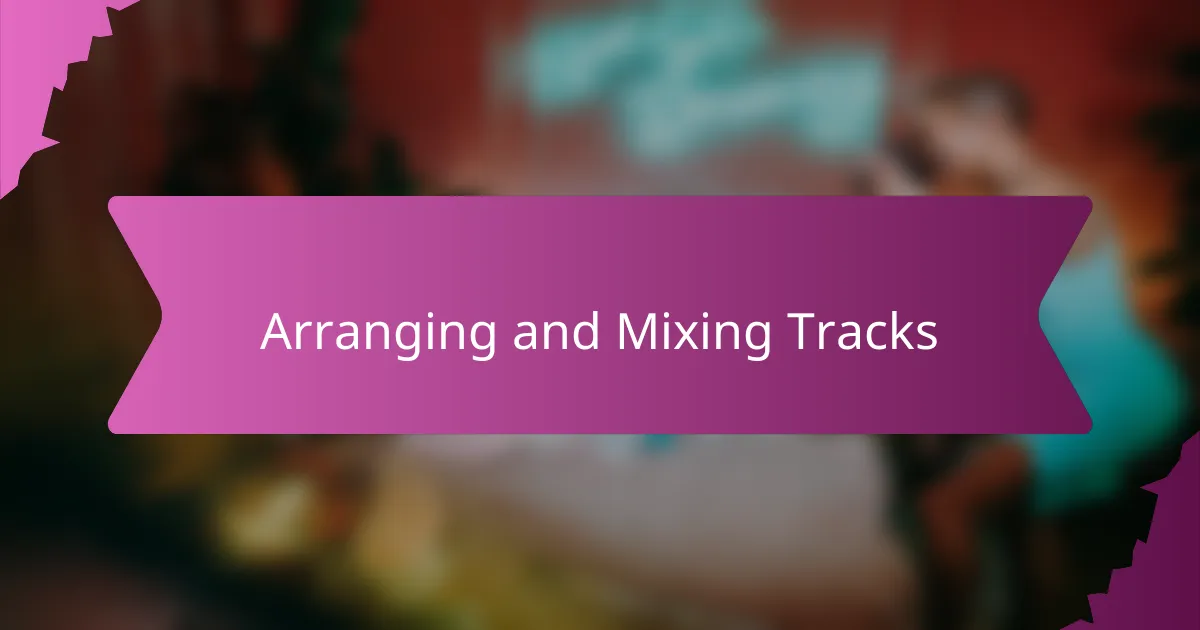
Arranging and Mixing Tracks
When it comes to arranging tracks in Ableton Live, I find that the arrangement view becomes my playground for storytelling. Moving clips around and layering elements isn’t just technical—it’s like composing a narrative where every section builds anticipation or releases tension. Have you ever noticed how dragging a simple drum loop to the right moment can completely change the energy of a track? That’s arranging magic for me.
Mixing, on the other hand, is where I get to sculpt sounds and create space for each instrument to breathe. Ableton’s flexible routing and intuitive mixer let me quickly experiment with EQ and compression to carve out clarity. I remember one session when a muddy bassline suddenly popped through just because I nudged the EQ slightly—that small tweak made all the difference.
What’s really rewarding is automating levels and effects during mixing to inject life into the track. Drawing volume fades or filter sweeps feels less like a chore and more like painting with sound. It’s these subtle shifts that keep a listener hooked, making the difference between a static track and one that feels alive. Do you find those tiny automation details as satisfying as I do?
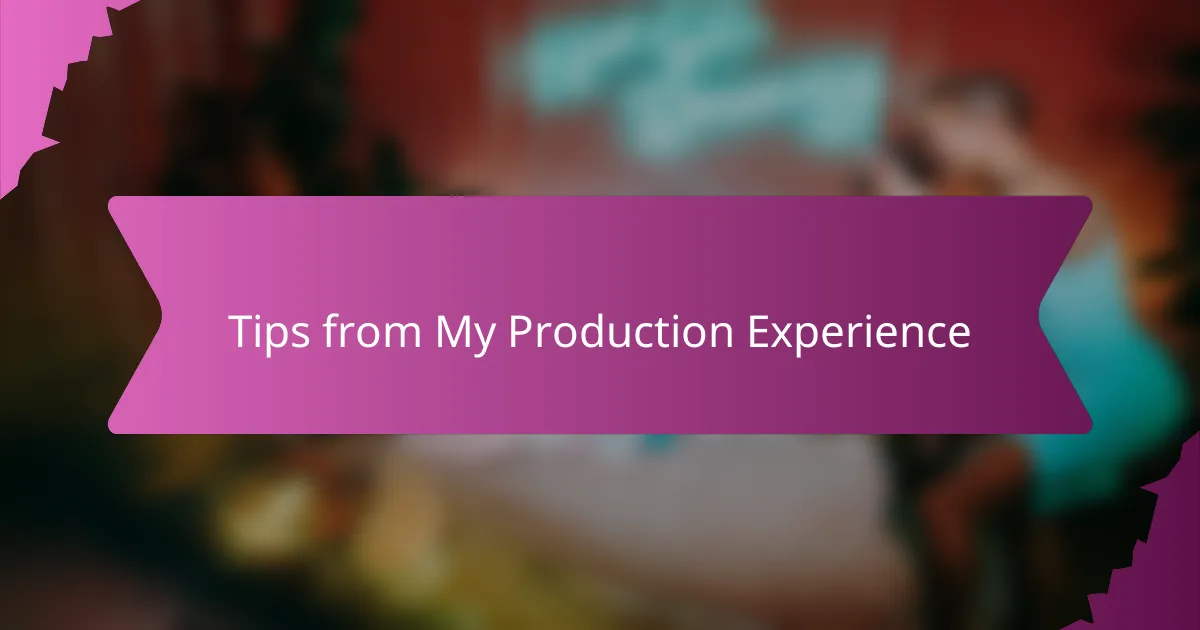
Tips from My Production Experience
One tip that transformed my workflow was embracing the idea of “less is more” in production. Early on, I loaded my projects with dozens of tracks and effects, thinking complexity meant quality. But I quickly realized that stripping things back, focusing on the essentials, actually made my music breathe and connect better with listeners. Have you tried simplifying your sessions to let key elements shine? It’s a game changer.
Another thing I learned is to save different versions of my project as I go. At first, I didn’t bother, and losing a favorite mix or idea was pure frustration. Now, having a clear snapshot of each stage lets me experiment without fear—if something feels off, I can always go back. This habit gave me the confidence to take creative risks and explore new directions.
Also, I can’t stress enough how important it is to take breaks during production. When I’m deep in the zone, it’s tempting to push through nonstop, but stepping away helps me hear the track fresh and catch things I might miss otherwise. Have you ever listened to a track after a rest and noticed details you overlooked before? Those moments really sharpen your perspective and elevate the final result.